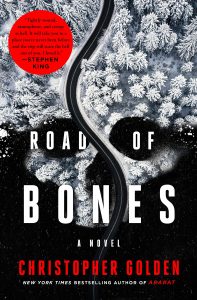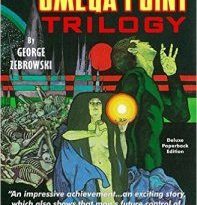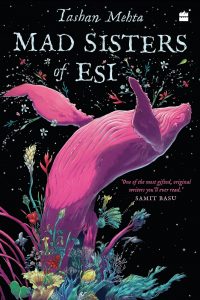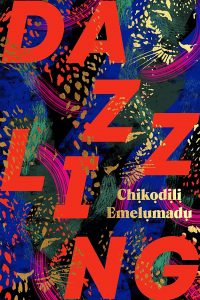Gabino Iglesias Reviews Road of Bones by Christopher Golden
 Road of Bones, Christopher Golden (St. Martin’s Press 978-1-25027-430-3, $27.99, 240pp, hardcover) January 2022.
Road of Bones, Christopher Golden (St. Martin’s Press 978-1-25027-430-3, $27.99, 240pp, hardcover) January 2022.
Christopher Golden’s Road of Bones packs a mixture of horror and adventure its 240 pages that makes it feel like a 100-page novella. Full of memorable characters and taking place in a truly unique and inhospitable location, the narrative walks a fine line between an all-out horror story about impossible creatures threatening a group of people and a story about perseverance and friendship that looks at the way we’re haunted by past experiences, history, our own failures, and even past relationships.
Siberia’s Kolyma Highway, also known as the Road of Bones, is a 1,200-mile ‘‘highway’’ of permafrost right at the edge of the Arctic Circle. Dotted by scarcely populated specks on the map, the deadly highway is full of stories, and it gets its name from the human bones buried in it, most from those in gulags who were forced to work there. Because of these unique elements, documentary producer Felix ‘‘Teig’’ Teigland has flown to Russia with his friend Prentiss, and they’re driving the highway and getting some footage they can use to pitch a series Teig thinks will be a hit: Life and Death on the Road of Bones. The two friends pick up a guide and make their way to the small town of Akhust, known as ‘‘the coldest place on Earth,’’ and feel like the idea might just work after all. However, there’s something bad waiting for them in Akhust. The people are gone, their houses open to the deadly cold and abandoned. Then something comes out of the frozen woods at the edge of town and Teig, Prentiss, a woman they picked up along the way, and the guide’s niece, whom they found in one of the abandoned homes in a state of shock, find themselves on the run from wolves that aren’t quite wolves and something else they can’t even begin to comprehend.
While there is a lot of action, horror, cold, violence, and blood, the first thing that makes Road of Bones a great read is that it’s a character-driven narrative. Amidst all the chaos and death, the story itself relies heavily on Teig and Prentiss’s friendship. Prentiss is there in part because Teig, whose projects sometimes work out for a short time but mostly fall flat and end up making everyone involved lose money, owes him money. Teig wants to pay and wants this project to work out, but he’s insecure, and when things go south and Prentiss gets seriously hurt, he has a hard time processing it and has to deal with guilt and grief on top of the mayhem around him.
While Teig is the main character and Prentiss a secondary but very important one, they are not alone. The guide becomes an important source of information and allows Golden to set the atmosphere. The woman they find stranded in the cold next to her car and the guide’s niece also become important characters in the narrative. In fact, some of the secondary characters in this novel are as memorable as Teig. For example, Ludmilla, an old woman who walks the Kolyma Highway praying for the dead buried under it, is impossible to forget. She felt the calling of the dead as a young girl, heard their lamentations and knew they were trapped there because they hadn’t received a proper burial, so she has spent years doing that, mile by mile, all under the crushing cold:
She stood in the dark, the cold gnawing down to the bone, and kept the gas can tilted so fuel would burble out and fill her tank. All of the walking she did, the moving and lifting, kept her fairly fit for a woman her age, but she could not pretend her little crusade had not begun to wear her down. There were four gas cans in her trunk. She was on the second one now, replenishing the fuel she had burned by leaving her car running as she moved up and down the highway, saying her prayers and singing funeral songs over the bones of people who’d been dead for decades.
Besides the human characters, there are things in this novel that become so crucial that they almost become secondary characters. The first one is the cold itself. There’s the kind of cold where you stay inside because it isn’t pleasant outside or you’re afraid of sliding down some icy stairs. In Akhust, cold is different than that: it can kill you in a few minutes, burn any exposed skin, freeze gas lines if you turn your vehicle off, etc. In the coldest place on Earth, the cold is a constant threat, and Golden shows that perfectly. Also, there are the wolves – or the not-exactly-wolves – who follow the group, stalk them where they stay, and are able to run alongside the truck for miles and miles in the extreme cold. And, lastly, there’s the parnee, a shaman who’s also more than that; he’s something so ingrained in the culture and folklore of the place that it’s impossible for the locals to explain him to the Americans, even when they know that some strange, long man is following them and singing a song out there that is somehow entering their ears and affecting the way they feel and what they see:
She had told the American the parnee was a shaman, and this was true, but how could she explain the difference between the shamanist faith shared by so many people in her country and what the parnee was, what the stories said it had been in the past, how powerful and terrifying it could be when the times demanded it? A summer rain could be called a storm, but a winter blizzard that might bury a town or freeze a horse dead in its tracks… that was also a storm. The shamans, who were people, might speak with nature, but the parnee breathed nature, danced in nature, screamed nature’s grief. And like nature, the parnee could be merciless.
Golden has found a way to take readers into a world of ice, violent monsters, and barren trees, and then show them a lot of heart. Road of Bones is a story of people being relentlessly pursued by supernatural monsters, but it’s also about humanity, friendship, helping others, and even trying to help the dead, and that’s what truly makes this a memorable novel and a standout in Golden’s already impressive oeuvre.
Gabino Iglesias is a writer, journalist, professor, and book reviewer living in Austin TX. He is the author of Zero Saints and Coyote Songs and the editor of Both Sides. His work has been nominated to the Bram Stoker and Locus Awards and won the Wonderland Book Award for Best Novel in 2019. His short stories have appeared in a plethora of anthologies and his non-fiction has appeared in the New York Times, the Los Angeles Times, and CrimeReads. His work has been published in five languages, optioned for film, and praised by authors as diverse as Roxane Gay, David Joy, Jerry Stahl, and Meg Gardiner. His reviews appear regularly in places like NPR, Publishers Weekly, the San Francisco Chronicle, Criminal Element, Mystery Tribune, Vol. 1 Brooklyn, the Los Angeles Review of Books, and other print and online venues. He’s been a juror for the Shirley Jackson Awards twice and has judged the PANK Big Book Contest, the Splatterpunk Awards, and the Newfound Prose Prize. He teaches creative writing at Southern New Hampshire University’s online MFA program. You can find him on Twitter at @Gabino_Iglesias.
This review and more like it in the March 2022 issue of Locus.
 While you are here, please take a moment to support Locus with a one-time or recurring donation. We rely on reader donations to keep the magazine and site going, and would like to keep the site paywall free, but WE NEED YOUR FINANCIAL SUPPORT to continue quality coverage of the science fiction and fantasy field.
While you are here, please take a moment to support Locus with a one-time or recurring donation. We rely on reader donations to keep the magazine and site going, and would like to keep the site paywall free, but WE NEED YOUR FINANCIAL SUPPORT to continue quality coverage of the science fiction and fantasy field.
©Locus Magazine. Copyrighted material may not be republished without permission of LSFF.







